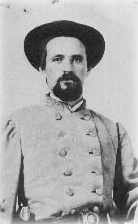| Colonel Albert Miller Lea by Mrs. G. H. Scholle, Originally published in "The Navarro County Scroll", Vol. XXI 1981 Courtesy of the Navarro County Historical Society (all rights reserved)
Lea, who gained his title as a member of the Texas Cavalry during the Civil War, was born July 23, 1808 at Granger County, Tennessee. Following graduation from Knoxville College, he entered West Point, where he was graduated in the class of 1831. The three years following this were spent in going to various parts of the country on topographical and scientific duties for the United States government. This work called him from the Great Lakes to the Gulf and from Oklahoma to Tennessee. It gave him a vast amount of information concerning the West and its few pioneers. Having completed an assignment of paying the Indians in Nebraska, Lea reported for duty at a newly established army post in the then Fort Des Moines. This was situated near the present town of Montrose in the southeastern part of Iowa, and under the government of the Michigan territory. Shortly after Lea's arrival, orders were received for an expedition to proceed up along the Des Moines River to a certain point, where it would strike northeast to the Indian village near Lake Pepin on the Mississippi River. Under the command of Lt. Col. Kearny, 150 mounted men with supply wagons started June 7, 1835, on this march, for the purpose of exploration and of impressing the Indians with the power of the United States government. These Dragoons were officered by Captain Nathaniel Boone, a son of Daniel Boon, Lt. Albert Lea, and Lt. Turner. In addition to his regular duties, Lt. Lea served as ordinance officer, and voluntarily assumed the duties of topographer. Using his watch and compass he sketched the route, lakes, distance traveled daily, and rate of their march. On reaching their destination on the Mississippi River, and conferring with the Indians at the Sioux Wabasha village, supplies were taken from the stern-wheeler Warrior. Soon the expedition was headed westward toward the head waters of the Des Moines River, hence they would follow it down to their starting place. They appeared in Freeborn County on the morning of July 28, 1835, in the northwest part of the county. That night, camp was made near the north shore of the lake which now bears Lea's name. Lea in later years stated that a fox had run through the column of soldiers while he was sketching the lake, and he had designated it as Fox Lake. A few years later official maps showed the lake as Lake Albert Lea, being named in Lt. Lea's honor. On July 29, 1835, the midday rest for dinner was on the north shore of White's Lake, some 2 1/2 miles northeast of what is now Albert Lea, Minn. Lea designated the lake as Lake Chapeau, as it resembled a Frenchman's hat, and he named the prairie which he could see to the north as Paradise Prairie. Lee resigned from the army shortly after this expedition, and became interested in developing a tract of Iowa land. His land enterprise was not successful, and Lea went to Washington where he acted as chief clerk for the War Department. For a period, he was Secretary of War. Later he was a professor of mathematics at the University of East Tennessee. Lea married his first wife, Ellen Shoemaker, and had one son, Edward. Here is where the tragedy mentioned in the beginning of this article comes in. In the final battle for Galveston, Lea was with the Confederate forces. As the Bayou City, the Confederate boat, rammed the Harriett Lane, the Union boat, the two crafts locked together. "Cowards won't follow me!" dared Major Leon Smith, Confederate commander, leaping aboard the Harriett Lane. The wild Texas cavalrymen needed no urging. They came from behind their cotton bales with guns blazing. Aboard the Union ship, the commander, Mayhew Wainwright, was found dead, and his second in command, Edward Lea, dying. Lea's father was among the soldiers boarding the ship. Lea, seeing his son bleeding on the deck, rushed to the boy and knelt by his side. "Father is here," exclaimed the dying Yankee boy. Lea bent over his son with a prayer. It has been said that a short truce was declared while young Lea was given a Masonic funeral by the members of the Order from both the North and the South. He is now buried in Galveston's Episcopal Cemetery. Following the death of his first wife, Lea married Catherine Daisy Heath, in Baltimore, Maryland. They had three children, Eliza or Lyda (sometimes spelled Lida), who never married; Alexander McKie, married and had one daughter, Katie; and Albert Lea, married and has three children. Lea's father, Major (a name, not a title) Lea, was born May 21, 1771, and died July 16, 1822. His grandfather, Luke Lea, was the son of the emigrant, James Lea, of Lea Hall on Lea River, Surrey, Cheshire, England. At the close of the War Between the States, Lea settled in Galveston, later moving to Corsicana, where he lived until his death, January 16, 1891, and he was buried in Oakwood Cemetery.
See Also:
Colonel Albert Miller Lea
|
 Many local families were deeply involved in the War Between the States but Colonel Albert Miller Lea was the participant in one of the most poignant stories coming out of that great conflict.
Many local families were deeply involved in the War Between the States but Colonel Albert Miller Lea was the participant in one of the most poignant stories coming out of that great conflict. CELEBRATION IN MINNESOTA
CITY RECALLS PIONEER
CELEBRATION IN MINNESOTA
CITY RECALLS PIONEER